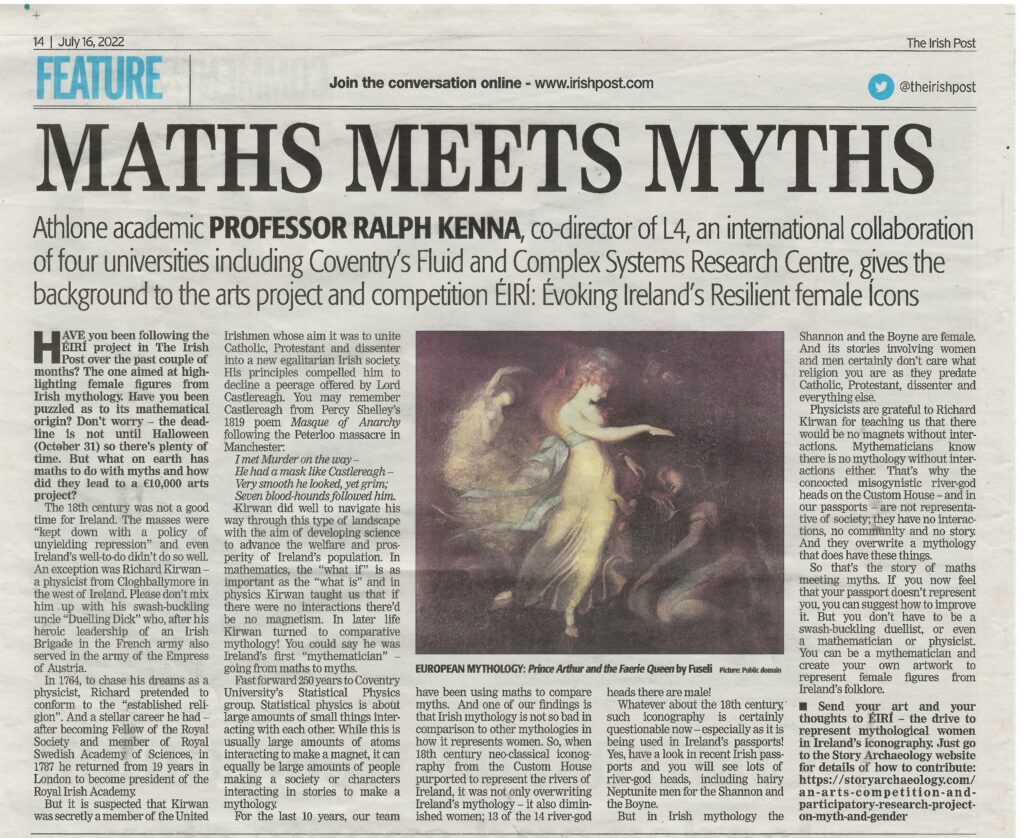Athlone academic Professor Ralph Kenna, co-director of L4, an international collaboration of four universities including Coventry’s Fluid and Complex systems Research Centre, gives the background to the arts project and competition ÉIRÍ: Évoking Ireland’s Resilient female Ícons

Have you been following the ÉIRÍ project in the Irish Post over the past couple of months? The one aimed to highlight female figures from Irish mythology. Have you been puzzled as to its mathematical origin? Don’t worry – the deadline is not until Halloween (31 October) so there’s plenty of time. But what on earth has maths to do with myths and how did they lead to a €10,000 arts project?
The 18th century was not a good time for Ireland. The masses were “kept down with a policy of unyielding repression” and even Ireland’s well-to-do didn’t do so well. An exception was Richard Kirwan – a physicist from Cloghballymore in the west of Ireland. Please don’t mix him up with his swash-buckling uncle “Duelling Dick” who, after his heroic leadership of an Irish Brigade in the French army also served in the army of the Empress of Austria.
In 1764, to chase his dreams as a physicist, Richard pretended to conform to the “established religion”. And a stellar career he had – after becoming Fellow of the Royal Society and member of Royal Swedish Academy of Sciences, in 1787 he returned from 19 years in London to become president of the Royal Irish Academy.
But it is suspected that Kirwan was secretly a member of the United Irishmen whose aim it was to unite Catholic, Protestant and dissenter into a new egalitarian Irish society. His principles compelled him to decline a peerage offered by Lord Castlereagh. You may remember Castlereagh from Percy Shelley’s 1819 poem Masque of Anarchy following the Peterloo massacre in Manchester:
I met Murder on the way—
He had a mask like Castlereagh–
Very smooth he looked, yet grim;
Seven blood-hounds followed him.”
Kirwan did well to navigate his way through this type of landscape with the aim of developing science to advance the welfare and prosperity of Ireland’s population. In mathematics, the “what if” is as important as the “what is” and in physics Kirwan taught us that if there were no interactions there’d be no magnetism. In later life Kirwan turned to comparative mythology! You could say he was Ireland’s first “mythematician” – going from maths to myths.
Fast forward 250 years to Coventry University’s Statistical Physics group. Statistical physics is about large amounts of small things interacting with each other. While this is usually large amounts of atoms interacting to make a magnet, it can equally be large amounts of people making a society or characters interacting in stories to make a mythology.
For the last 10 years, our team have been using maths to compare myths. And one of our findings is that Irish mythology is not so bad in comparison to other mythologies in how it represents women. So, when 18th century neo-classical iconography from the Custom House purported to represent the rivers of Ireland, it was not only overwriting Ireland’s mythology – it also diminished women; 13 of the 14 river-god heads there are male!
Whatever about the 18th century, such iconography is certainly questionable now – especially as it is being used in Ireland’s passports! Yes, have a look in recent Irish passports and you will see lots of river-god heads, including hairy Neptunite men for the Shannon and the Boyne.
But in Irish mythology the Shannon and the Boyne are female! And its stories involving women and men certainly don’t care what religion you are as they predate Catholic, Protestant, dissenter and everything else!
Physicists are grateful to Richard Kirwan for teaching us that there would be no magnets without interactions. Mythematicians know there is no mythology without interactions either. That’s why the concocted misogynistic river-god heads on the Custom House – and in our passports – are not representative of society; they have no interactions, no community and no story. And they overwrite a mythology that does have these things.
So that’s the story of maths meeting myths. If you now feel that your passport doesn’t represent you, you can suggest how to improve it. But you don’t have to be a swash-buckling dueller, or even a mathematician or physicist. You can be a mythematician and create your own artwork to represent female figures from Ireland’s folklore.
And you can send your art and your thoughts to ÉIRÍ – the drive to represent mythological women in Ireland’s iconography. Just go to the Story Archaeology website for details of how to contribute:
View all of the ÉIRÍ Competition articles from the Irish Post
